
A plan to rid England of bovine TB within 25 years has been set out today by Environment Secretary Owen Paterson.
The strategy sets out action in areas such as disease surveillance, pre- and post-movement cattle testing, removal of cattle exposed to bTB, tracing the potential source of infection and wildlife controls including culling and vaccination trials.
It also focuses on the development of new techniques such as badger and cattle vaccines and new diagnostic tests that could one day offer new ways of tackling the disease.
Launching the strategy Mr Paterson said: "28,000 otherwise healthy cattle were slaughtered last year because of bovine TB. Today we start a countdown towards an England free from this terrible disease. We must stop bTB spreading into previously unaffected areas while bringing it under control in places where it has taken hold. I have visited Australia, New Zealand, the Republic of Ireland and the USA and we must learn from their successful TB eradication programmes."

"Bovine TB is the most pressing animal health problem in the UK. It threatens our cattle farmers’ livelihoods and our farming industry as well as the health of wildlife and livestock. We must all work together to become TB free within 25 years."
The strategy follows up measures already in place and includes comprehensive packages tailored to three distinct risk areas across England.
Farm groups and veterinarians have welcomed the Government's TB strategy, the NFU said it should 'herald a fresh start in managing animal dieases' but the CLA said it was vital Defra works closely with landowners.
NFU President Peter Kendall said: “Owen Paterson committed to publishing a TB eradication strategy at NFU Conference in February and the publication of this document today is very significant for all cattle farmers. On balance, we think it is an ambitious and comprehensive package to deal with this terrible disease which is devastating the lives of tens of thousands of farmers and their families, and destroying farming businesses, every year.
“The strategy reflects the fact that a full range of cattle and wildlife measures will be needed. It also recognises the importance of a risk-based approach that puts the ability to trade responsibly at the heart of cattle controls to minimise risks of disease transmission while allowing businesses to continue to operate.
“The Government’s commitment to roll out a badger control programme to other TB High Risk areas after the successful completion of this year’s pilot trials is vital and welcomed by the farming industry. Delivering on this is absolutely critical if we are to eradicate TB in cattle and badgers.
“For the Government’s strategy to succeed, it has to take the industry – farmers and vets – along with it. In England, the pilot culls show that farmers are prepared to contribute towards elements of a disease control package, where they can see a clear value from the contribution they make in terms of reducing levels of TB.
“We need to work with Government and farmers to look at how delivery of badger control from next year can be best delivered. Farmers will also want to see that Government has done everything it can to make current TB controls cost effective by addressing, for example, the costs of administration.
“But above all, I call on the Government to use this strategy to look at adopting a new governance model where farmers have a much bigger say in disease control policy. The strategy highlights the success in New Zealand where government and farmers have joint ownership of the plans to tackle bovine TB. Farmers have a much bigger say on the disease policy and they have seen a massive impact on TB as a result. New and innovative thinking is required with this most challenging of animal diseases.”
CLA President Harry Cotterell said: “Bovine TB is devastating to farmers, rural businesses and landowners, and working towards a solution is a very complex process.
“We are pleased that the Government has now released this long over due strategy which seeks to eradicate this terrible disease from livestock and wildlife in England.
“It is vital that the Government now engages with landowners and farmers who are reliant on a healthy livestock sector.”
The CLA said the Association will engage with its members to gauge their views on the proposals outlined under the strategy.
The British Veterinary Association (BVA) and British Cattle Veterinary Association (BCVA) took part in the early stages of consultation and have welcomed the overall strategy with a view to consulting members of the veterinary profession on the detail.
Commenting, Peter Jones, President of the BVA, said:
“We have long argued that there is no single measure that can effectively tackle bovine TB on its own and so we are delighted that this strategy looks at the bigger picture and draws together all of the available tools in the toolbox.
“The document represents a new way of looking at the disease and we are pleased to note the development of area-based strategies that recognise the need for specific and differing approaches in endemic areas and edge areas.
“We are particularly pleased that for the first time the government is setting itself, and the industry and veterinary profession, specific targets. This will help us focus our efforts and pull together towards these goals and we will now be consulting our members and divisions on the draft strategy to hear their views on the role vets can play in achieving these targets.”
Jonathan Statham, President of BCVA, added:
“We welcome the publication of the draft strategy and are pleased that we have had the opportunity to input into the process.
“The overall strategy sets the right direction of travel towards eradicating bovine TB but we need to consider the detail and consult our members as the role of cattle vets will be crucial to the successful delivery of the strategy.
“We are currently developing proposals on how vets can deliver an enhanced service alongside TB testing, and this will soon be piloted in six areas of Wales through Cymorth TB. We look forward to developing similar proposals in England.”
Defra is working with the farming industry to introduce risk-based trading to help them make more informed decisions about the cattle they buy. A range of crucial TB risk information such as movement and testing history will be shared at the point of sale so farmers will know the animal’s TB testing history before purchase.
Chairman of the Animal Health and Welfare Board for England Michael Seals said: "The draft strategy is the outcome of collaboration between government and industry with one aim: to achieve bTB free status for England. Ongoing collaboration and investment by both parties will be essential to develop and deploy the necessary means to achieve this aim."
"The strategy, which has been developed by the Animal Health and Welfare Board for England (AHWBE) and the Bovine Tuberculosis Eradication Advisory Group for England (TBEAG) draws extensively on experiences in countries such as Australia, New Zealand, USA and the Republic of Ireland, all of which have shown the way to successfully tackle bovine TB through addressing the infection in cattle and in wildlife."
A crucial element is a consideration of options for governance, delivery and funding of the Strategy. The New Zealand experience in particular, demonstrates the significant potential benefits of having a robust government-industry partnership approach to tackling bTB.
